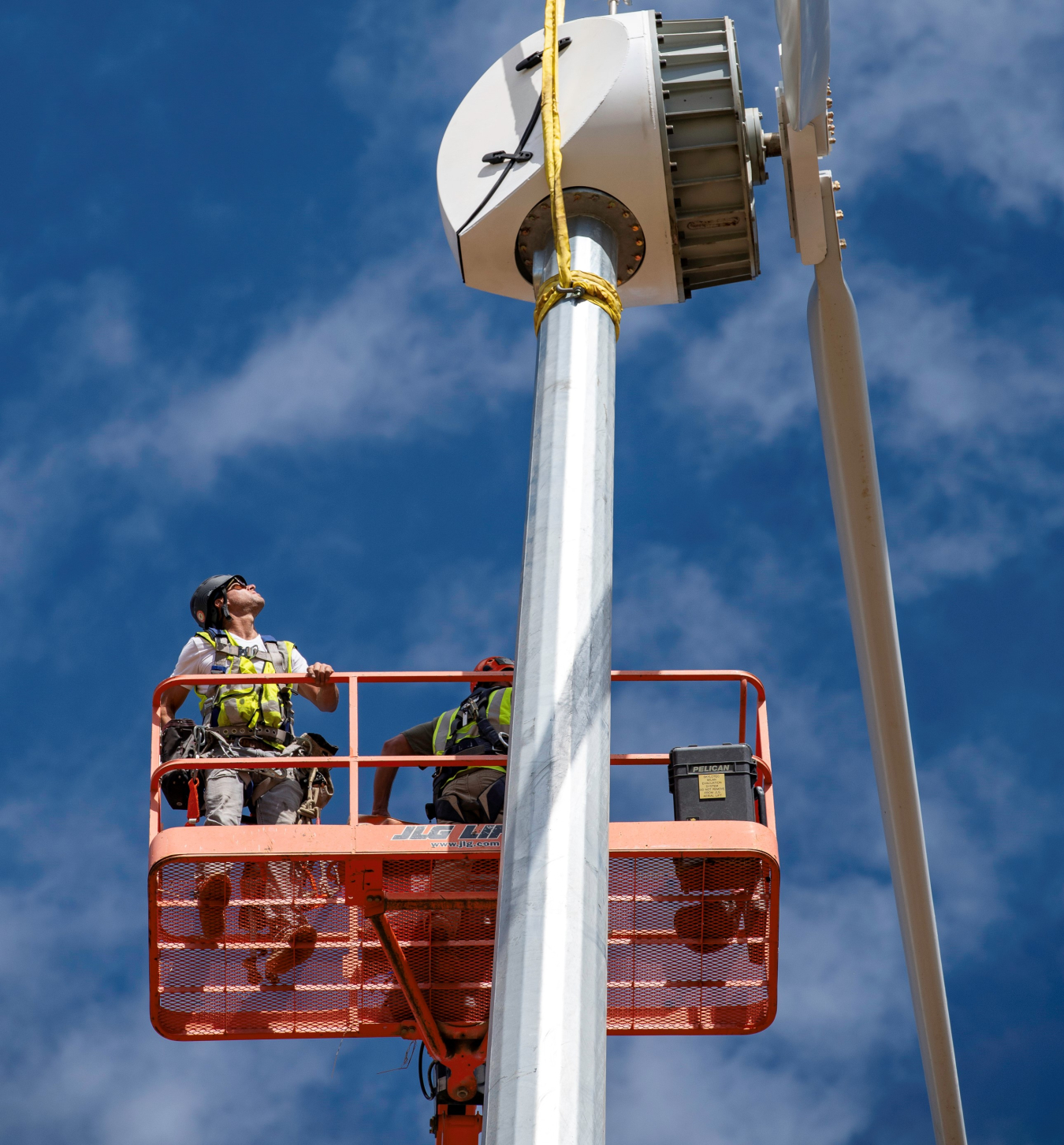With three recently installed small wind turbines at the Flatirons Campus in Colorado, WETO is poised to take the next step in proving and improving the next generation of distributed wind technologies.
Wind Energy Technologies Office
July 17, 2024Achieving a clean energy future is going to take energy of all kinds, and every little bit helps. Enter distributed energy resources (DERs), which generate, store, and manage power locally for energy users. Wind energy technology applied as a DER—known as distributed wind—is ideal for a wide range of customers. Installations can range from a less-than-1-kilowatt (kW) off-grid wind turbine powering telecommunications equipment to a 15-kW wind turbine at a home or small business to a 2.5-megawatt (MW) wind turbine at a university campus or industrial facility. If your location has the wind resources, then distributed wind energy might be your ticket to cleaner, lower-cost, and locally generated electricity.
Think this sounds like a breath of fresh air? The U.S. Department of Energy’s (DOE) Wind Energy Technologies Office (WETO) does, which is why we’re dedicated to advancing distributed wind energy throughout the United States. Through the Distributed Wind Aeroelastic Modeling (dWAM) project, researchers at DOE’s National Renewable Energy Laboratory (NREL) are helping provide the distributed wind energy industry with better tools to model, optimize, and certify improved wind turbine designs. And through the Competitiveness Improvement Project (CIP), WETO and NREL have worked with U.S. suppliers of distributed wind energy technologies to develop next-generation turbines and components, perform testing and certification, and commercialize their products.
With three recently installed small wind turbines (pictured and described below) at their Flatirons Campus in Colorado, NREL and WETO are poised to take the next step in proving and improving the next generation of distributed wind technologies.

Two workers installing the Bergey Windpower Excel 15, which is a 15-kW upwind, passive-yaw, stall-regulated, horizontal-axis wind turbine.

Wind turbines have many design characteristics that determine how they function, and researchers are studying a variety of these characteristics in the three distributed wind turbines. Some notable characteristics of interest are how a turbine is oriented to the wind direction (i.e., upwind or downwind), as well as how the turbine stays in alignment with the wind (i.e., passive-yaw, in which the wind pushes the turbine into alignment like a weather vane; or active-yaw, in which the turbine uses sensors to detect the wind direction and turns into the wind using a yaw motor).
Other noteworthy design characteristics are how the turbine’s power and speed are controlled (i.e., stall-regulated machines, in which the blades are designed such that as wind speeds increase beyond a certain point, the blades capture progressively less energy and do not spin more quickly; or pitch-regulated, in which the turbine senses the wind speed and as wind speeds increase beyond a certain point, actively rotates the blades into or out of the wind to capture less energy and keep the turbine at the desired speed). The new turbines installed at NREL’s Flatirons Campus will enable research on turbine design characteristics common to small wind turbines used in distributed applications.

In addition, these turbines will facilitate research and development on better integration of distributed wind with other DERs, with a focus on needed innovation for the technologies to be used in emerging distributed generation markets, including hybrid systems, microgrids, and virtual power plants. WETO’s investments will support and complement research and testing of wind, solar, storage, diesel, and other distributed energy technologies in a range of sizes as part of NREL’s Distributed Integrated Energy Laboratory, a research component of the Advanced Research on Integrated Energy Systems (ARIES) platform and a facility within DOE’s national laboratory system.
Don’t be fooled by the smaller capacity of distributed wind projects, relative to utility-scale land-based and offshore wind. Distributed wind energy has the potential to power more than half of the nation’s annual electricity consumption. The Distributed Wind Energy Futures Study found that nearly 1,400 gigawatts (GW) of distributed wind capacity could be profitably deployed across the United States. While agricultural lands have the most distributed wind potential at hundreds of GWs, residential, commercial, and industrial lands also have GW-scale potential. Additionally, distributed wind energy could potentially reduce energy burden for many disadvantaged communities that have significant wind resources.
WETO’s distributed wind activities also include the new National Distributed Wind Network and complementary Distributed Wind Energy Resource Hub. These resources provide people and communities interested in installing distributed wind turbines the information, tools, and connections they need to make informed decisions about distributed wind deployment.
All of this progress and potential for research and development of distributed wind energy is exciting, but it can be tough to imagine the many potential uses of distributed wind in your community. To visualize how distributed wind energy could diversify local energy sources to help provide clean renewable energy in a variety of scenarios, check out our distributed wind animation below. This interactive animation allows you to visually explore how distributed wind could be used in your local community, with examples spanning from residential to agricultural. We hope you experience a gust of inspiration. ?
Author
Heather Doty is a communications specialist supporting the U.S. Department of Energy’s Wind Energy Technologies Office.
CIP and the National Distributed Wind Network support DOE and the U.S. Department of Agriculture’s new Rural and Agricultural Income & Savings from Renewable Energy (RAISE) Initiative, which is focused on helping farmers, rural small businesses, and electric cooperatives cut costs and increase income from clean energy. 2024 CIP selections will provide more certified technology options for deployment in support of the RAISE initiative.
In addition, CIP awards will assist partnerships among distributed wind developers, farm groups, and agribusinesses to advance business models that increase access to distributed wind energy and help achieve clean energy goals set by RAISE and the Biden-Harris Administration.
Learn more about DOE’s work on distributed wind energy.


